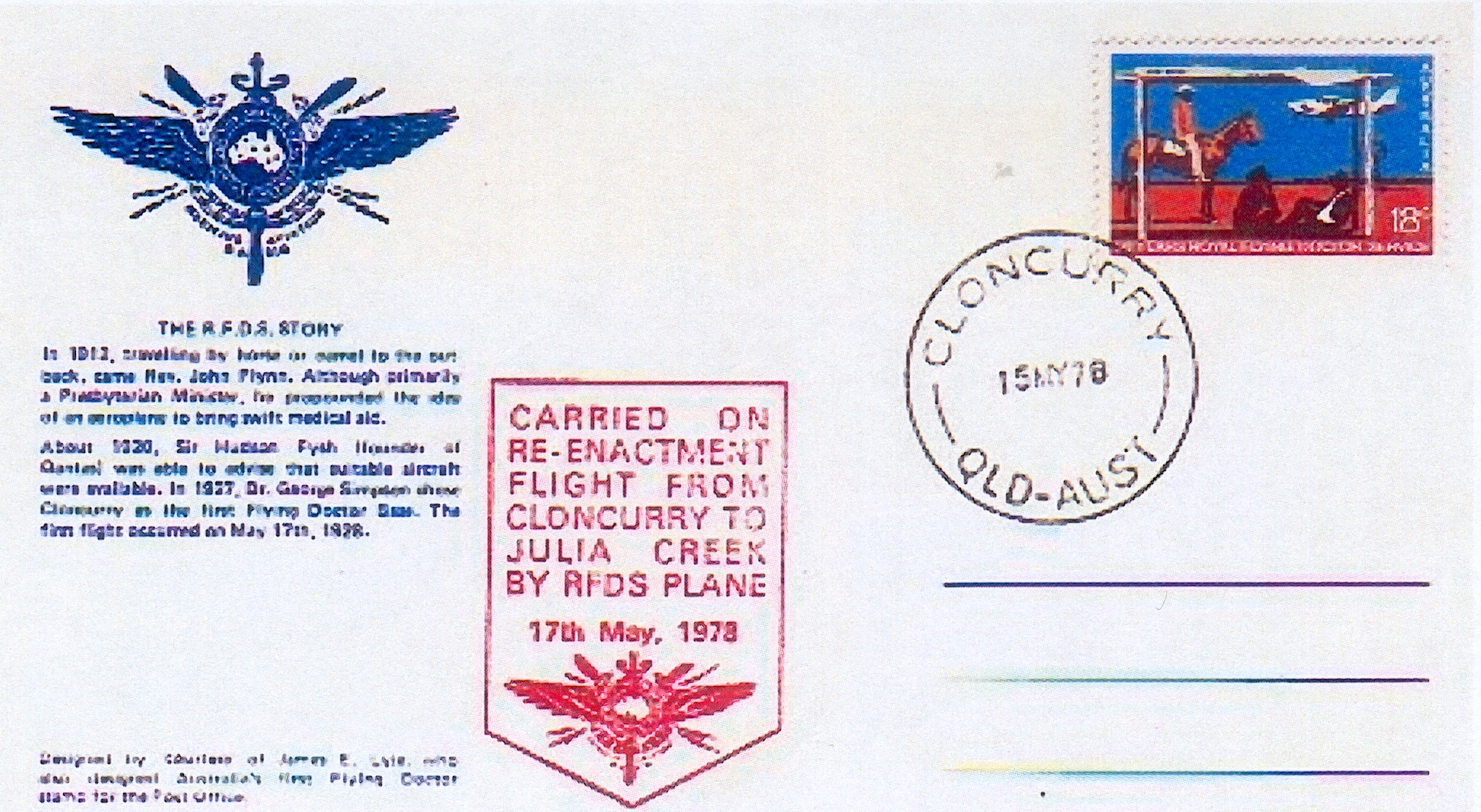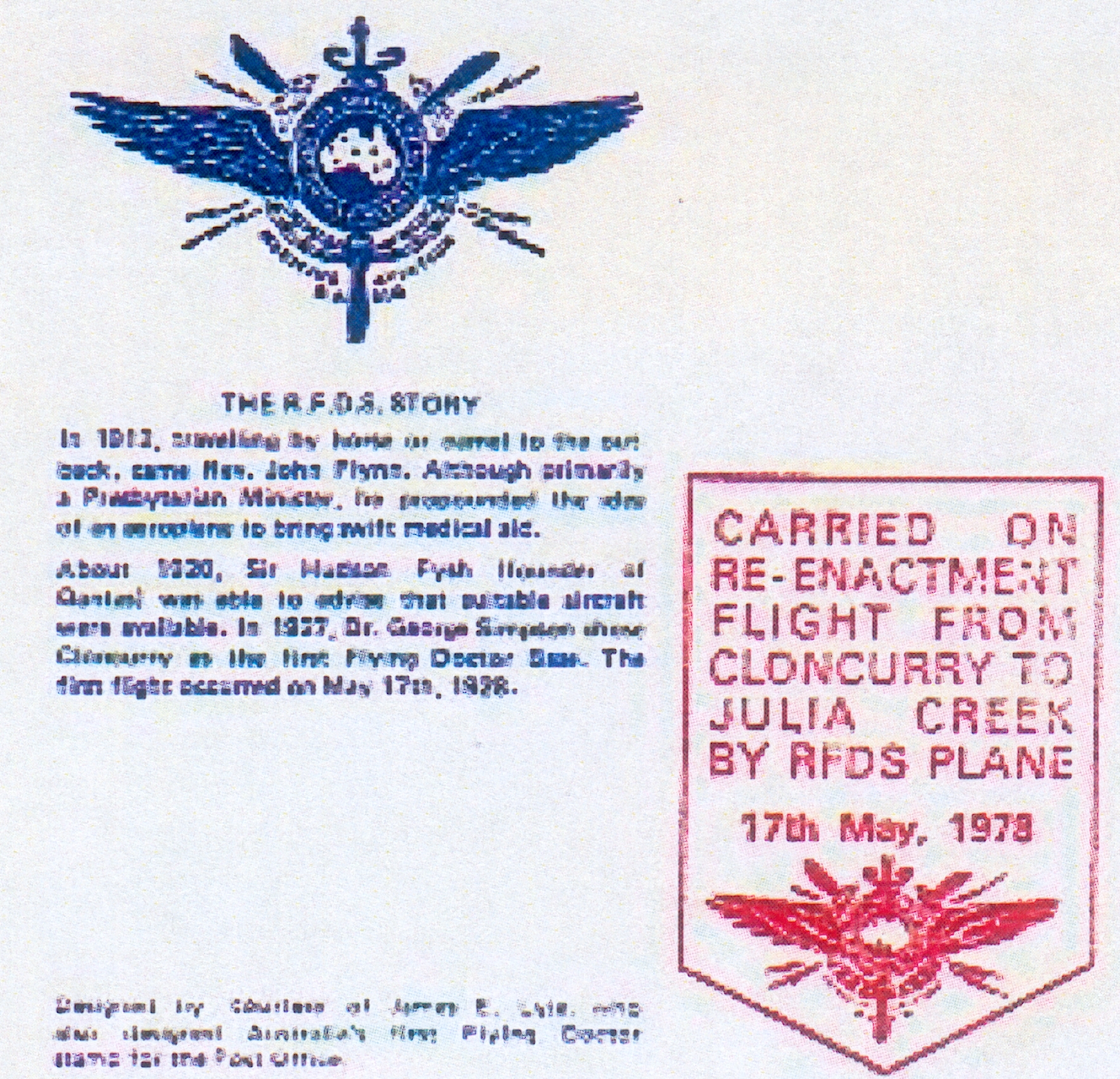

This cover celebrates the re-enactment of the first flight after 50 years of this successful medical service, and it shows the blue printed ‘Wings’insignia of the service, below which there is a short history of the organization, as well as a printed red ‘Shield’ outlining the re-enactment of the original flight from Cloncurry, Queensland to Julia Creek Queensland by the R.F.D.S. Plane. The multicoloured 18 cent stamp showed 3 men, one on horseback, 2 under rudimentary shelter, one, the patient has a white sling on his left arm, with the plane flying above in a vivid outback scene. The stamp was canceled CLONCURRY/ 15 MY 78/ QLD-AUST,which was the date of the stamp’s issue (Figures 1 & 2).
The reverse details the actual dates of the original flight and the 50th Anniversary re-enactment, and the 2 planes are featured, the D.H. 50 DE HAVILLAND and the Beechcraft B 80. Below the wings the small white circle shows the flight was from Cloncurry to Julia Creek, QLD, with a postmark JULIA CREEK/ 17 MY 78/ QLD-AUST. The doctor and the pilot signatures are both given for both flights, but only the original flight signatories have been identified to-date, as shown in the underlined sentence immediately below (Figure 3).
Prior to the first Qantas flight, a young Australian air force pilot named Lieutenant J. Clifford Peel while on a boat to fight France, set out a detailed proposal to establish an aero medical service for the outback. The recipient of the letter, the Reverend John Flynn, was so impressed by the proposal he had it published in the Churches “Inlander” magazine. Unfortunately Peel was killed in action in WW1, but Flynn pushed on with the idea. After several years of fund rasing Flynn had raised enough money to establish the first flying doctor scheme. Backers of the project included Hudson Fysh at Qantas, H. V. McKay, manufacturer of the Sunshine Harvester and a young doctor named Dr George Simpson. On the 15th of May 1928 a one-year trial of the Aerial Medical Service was established in Cloncurry. Two days later the first call out was received and the crew consisting of Qantas pilot Arthur Affleck and Surgeon Dr Kenyon St Vincent Welch flew to Julia Creek to attend to their first patient. 225 patients were treated and 50 flights were made in the first year and at least four lives were saved. It took only a few weeks to identify the fact that raising the alarm in time to save a critically ill patient was the scheme’s greatest hurdle. To the rescue came the electrical engineer, Alfred Traeger, who invented the pedal wireless for communicating across the vast distances. Soon the pedal wireless and the flying doctor were to become icons of medicine in the Australian bush.
John Flynn and Dr Alan Vickers pushed for the establishment of a network of flying doctor bases across the country with government support. Soon their dream was realised and the organization grew in to a national organization that still ran on public donation, with occasional government subsidies (Regular government grants only became established practice later on.). In 1936 the Australian Aerial Medical Service was renamed the Flying Doctor Service and the Queen granted the use of the Royal prefix in 1955. Today the RFDS has 19 bases covering more than 7 million square kilometres of Australia. The RFDS Queensland Branch in 1999 performed 47000 patient consultations held 1314 clinics and flew in excess of 300,000 km per month. The website of the Royal Flying Doctor Service gives an update to some of the statistics for the entire Australian outback as follows: 53 Planes, 21 Bases, 964 Staff and ca. 270,000 patients treated per year.
Arthur Affleck was born in Melbourne in 1903 and educated at Wesley College, in that city. At the age of 17 he joined the staff of the National Bank of Australasia but, after two years’ service, enlisted as a clerk in the Royal Australian Air Force.
In May 1928, Kenyon St Vincent Welch made the first emergency flight from Cloncurry to Julia Creek, on board a De Havilland model DH50 aircraft hired from the Queensland and Northern Territory Aerial Services Ltd (later to become Qantas). Welch had been selected from 22 applicants responding to an advertisement in the Australian Medical Journal. The position was for a full time doctor, to be paid 1000 pounds per year, whose duties would be to attend all urgent medical and accident cases, as well as to make regular visits to remote places lacking other medical services. It was also stipulated that the Flying Doctor would neither be allowed to practise privately, nor likely have the time to do so.
“There was an outstanding applicant: Dr Kenyon St Vincent Welch. He was a well-established Sydney surgeon of early middle age, prepared to leave home, family, and practice for 12 months because he had always wanted to work in some such manner and had been unable to serve in the First World War.”
Welch took up his duties at Cloncurry on 15 May 1928 and made his first flight two days later in a single engine, fabric covered, cabin bi-plane capable of carrying a pilot and four passengers at a cruising speed of just under 80 miles per hour. Welch and the pilot flew from Cloncurry to Julia Creek, (approximately 100 kilometres) to attend to two patients at the Julia Creek Bush Nursing Home, one of whom had attempted suicide by trying to cut his own throat. Welch landed nearby, walked to the nursing home and successfully performed two minor operations.
Typical entries from the doctor’s diary suggest that it was not uncommon for him to “make a 300km flight before breakfast, perform an operation then be back to base by lunchtime, flying at night only on urgent cases, landing in paddocks and rough clearings.”
Not only did Welch have to fly great distances to try to reach a patient in time, often this was stalled by difficult weather and flying conditions. A photo of Dr. Welch is seen in Figure 5.
Six months later he was selected as one of three Civil Aviation Cadets from hundreds of applicants throughout Australia, was trained to Air Force ‘Wings’ and Commercial Pilot Licence standard. Given a discharge from the RAAF, Affleck commenced work as a commercial pilot with Jimmy Larkin’s Australian Aerial Services Ltd. to operate the Melbourne-Hay route. Following a dispute with Larkin over the airworthiness of the A.N.E.C. III, Arthur Affleck obtained a job with Q.A.N.T.A.S in April 1927. He was the original pilot of the Flying Doctor service, based in Cloncurry, and later flew in New Guinea and Western Australia. A photo of Arthur Affleck is seen in Figure 4.